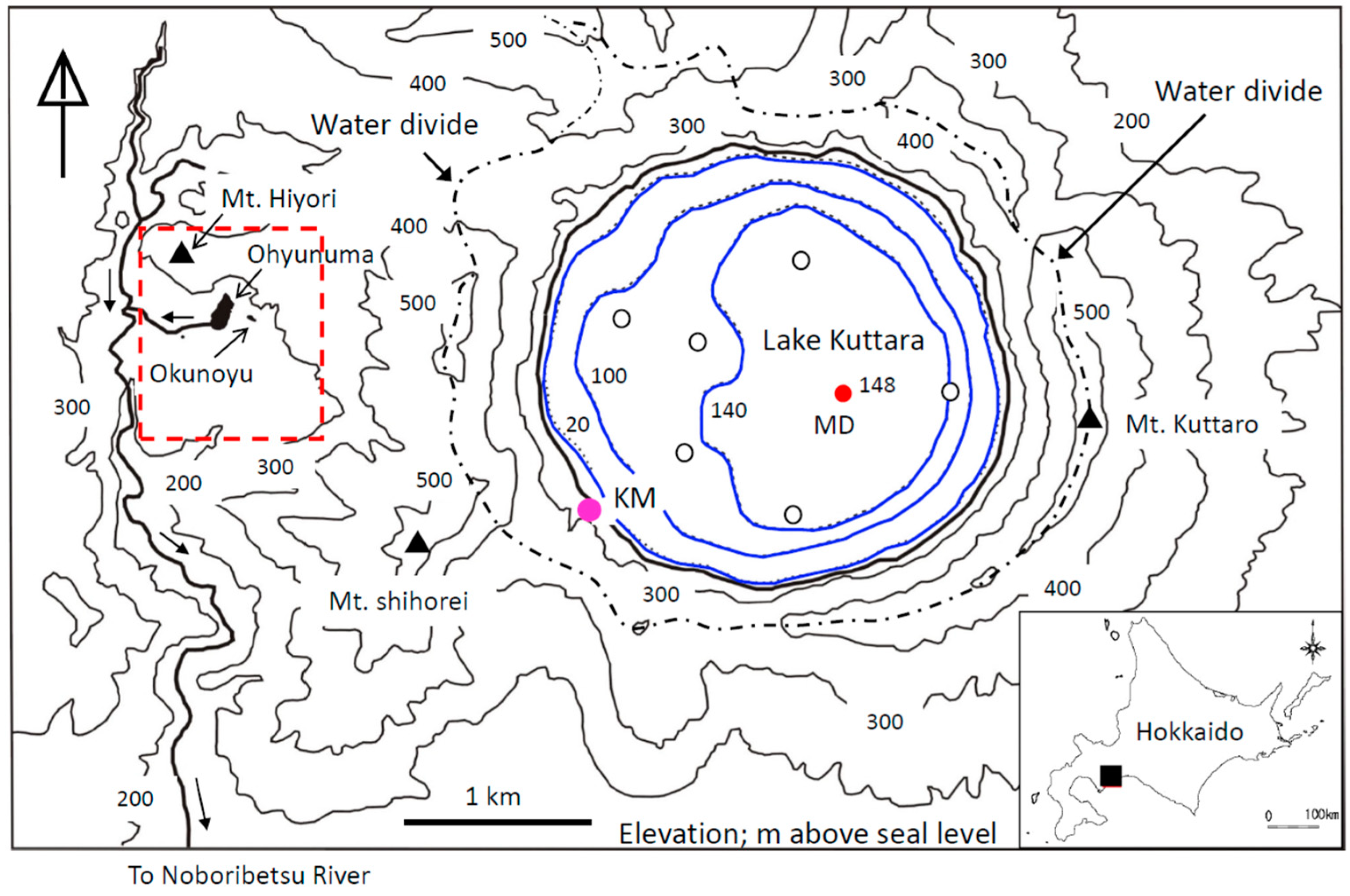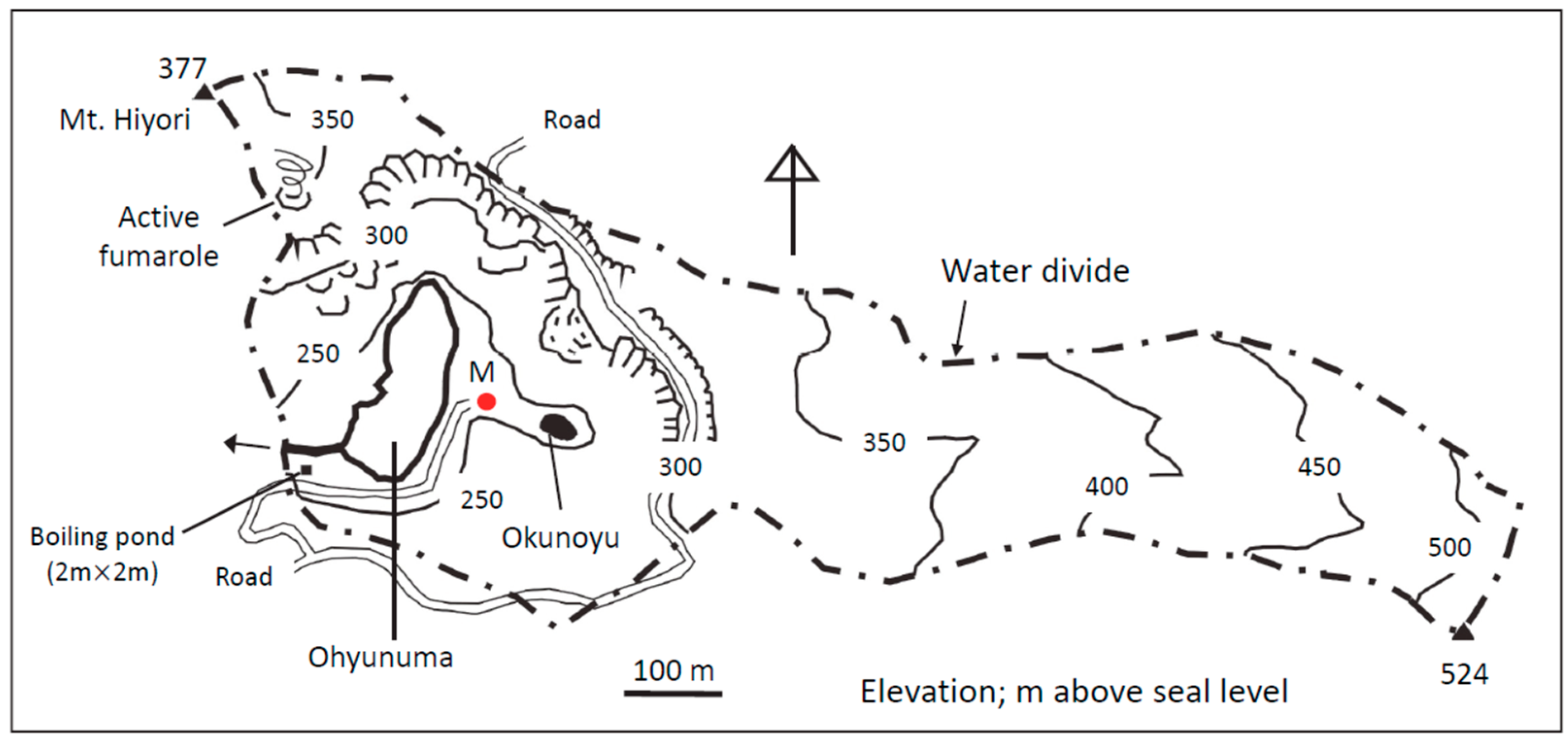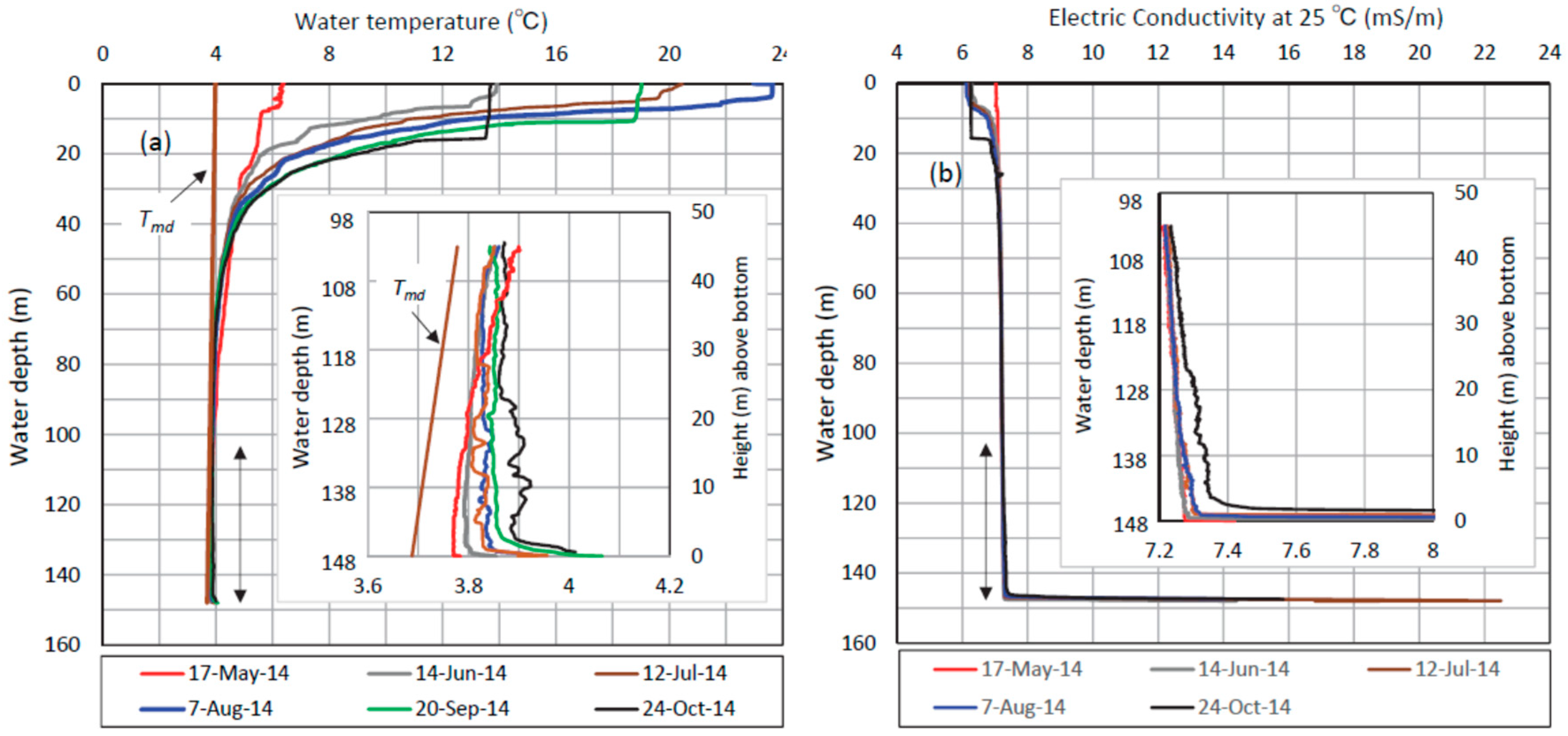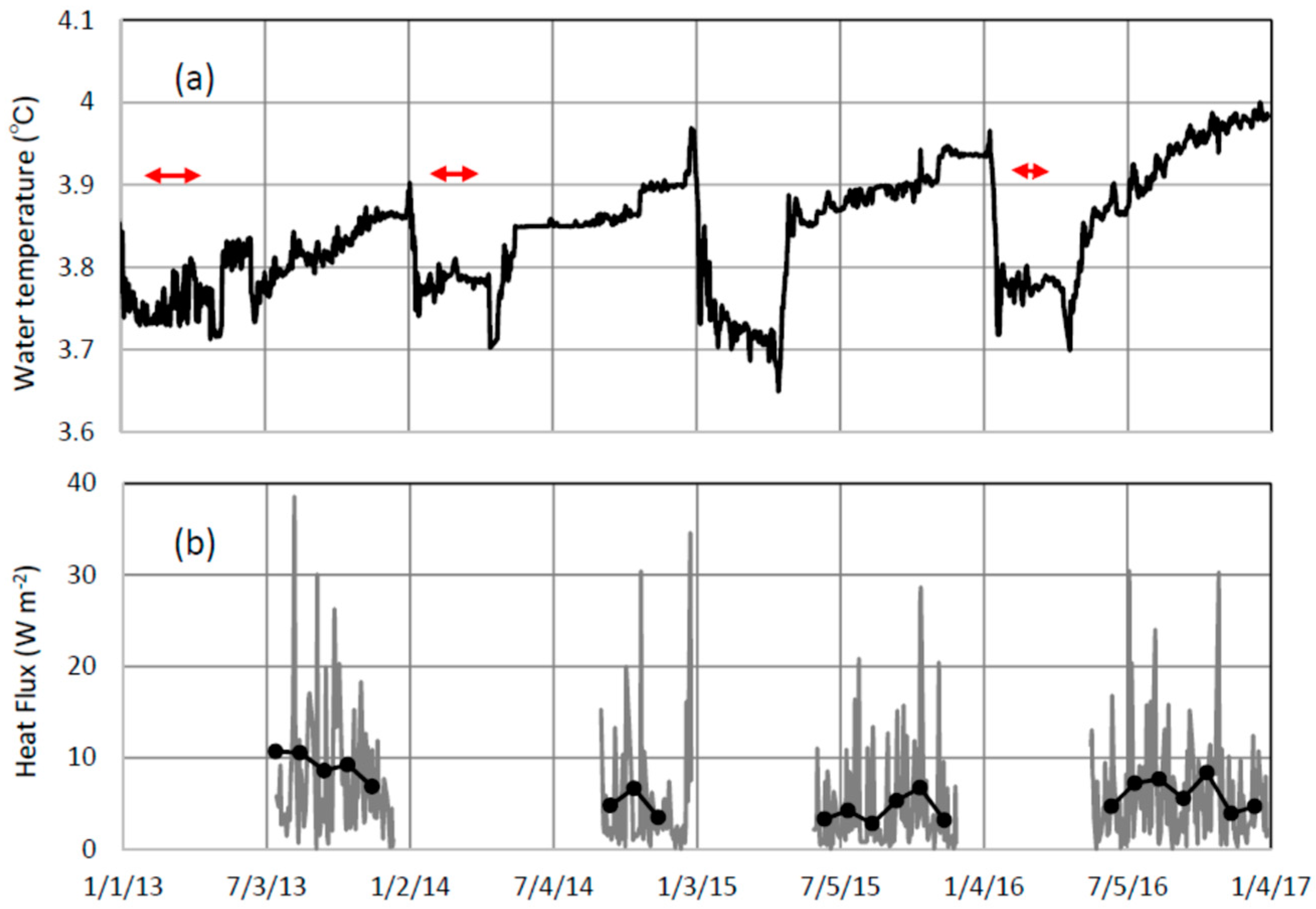Geothermal Linkage between a Hydrothermal Pond and a Deep Lake: Kuttara Volcano, Japan
Abstract
1. Introduction
2. Methodology
2.1. Field Observations
2.2. Heat Budget and Geothermal Heat Flux in a Hydrothermal Pond
3. Results and Discussion
4. Conclusions
Author Contributions
Funding
Acknowledgments
Conflicts of Interest
References
- Rouwet, D.; Tanyileke, G.; Costa, A. Cameroon’s Lake Nyos gas burst: 30 years later. Meeting report on 9th Workshop of the IAVCEI-Commission on Volcanic Lakes (CVL9); Cameroon, 14–24 March 2016. Eos 2016, 97. [Google Scholar] [CrossRef]
- Schilling, S.P.; Doelger, S.; Bacon, C.R.; Mastin, L.G.; Scott, K.; Nathenson, M. Digital data for volcano hazards in the Crater Lake region, Oregon (data to accompany USGS Open-File Report 97-487). Open-File Report; U.S. Geological Survey, 2008. Available online: http://pubs.usgs.gov/of/2007/1223/index.html (accessed on 29 June 2018).
- Hurst, A.W.; Bibby, H.M.; Scott, B.J.; McGuinness, M.J. The heat source of Ruapehu Crater Lake; deductions from the energy and mass balances. J. Volcanol. Geotherm. Res. 1991, 46, 1–20. [Google Scholar] [CrossRef]
- Hurst, A.W. Stochastic simulation of volcanic tremor from Ruapehu. J. Volcanol. Geotherm. Res. 1992, 51, 185–198. [Google Scholar] [CrossRef]
- Hurst, A.W.; Vandemeulebrouck, J. Acoustic noise and temperature monitoring of the crater lake of Mount Ruapehu Volcano. J. Volcanol. Geotherm. Res. 1991, 71, 45–51. [Google Scholar] [CrossRef]
- Hurst, T.; Christenson, B.; Cole-Baker, J. Use of a weather buoy to derive improved heat and mass balance parameters for Ruapehu Crater Lake. J. Volcanol. Geotherm. Res. 2012, 235–236, 23–28. [Google Scholar] [CrossRef]
- White, D.E.; Brannock, W.W. The sources of heat and water supply of thermal springs, with particular reference to Steamboat Springs, Nevada. Trans. Am. Geophys. Union 1950, 31, 566–574. [Google Scholar] [CrossRef]
- Fukutomi, T.; Sugawa, A.; Fujiki, T. A Geophysical study on the hot spring of Kawayu, Hokkaido. Geophys. Bull. Hokkaido Univ. 1956, 4, 39–64. [Google Scholar]
- White, D.E. Thermal waters of volcanic origin. Bull. Geol. Soc. Am. 1957, 68, 1637–1668. [Google Scholar] [CrossRef]
- Terada, A.; Hashimoto, T. Variety and sustainability of volcanic lakes: Response to subaqueous thermal activity predicted by a numerical model. J. Geophys. Res. Solid Earth 2017, 122. [Google Scholar] [CrossRef]
- Murozumi, M.; Abiko, T.; Nakamura, S. Geochemical Investigation of the Noboribetsu Oyunuma Explosion Crater Lake. J. Volcanol. Soc. Japan 1964, 11, 1–16. [Google Scholar]
- Ohba, T.; Hirabayashi, H.; Nogami, K. Temporal changes in the chemistry of lake water within Yugama Crater, Kusatsu-Shirane Volcano, Japan: Implications for the evolution of the magmatic hydrothermal system. J. Volcanol. Geotherm. Res. 2008, 178, 131–144. [Google Scholar] [CrossRef]
- Rouwet, D.; Tassi, F.; Mora-Amador, R.; Sandri, L.; Chiarini, V. Past, present and future of volcanic lake monitoring. J. Volcanol. Geotherm. Res. 2014, 272, 78–97. [Google Scholar] [CrossRef]
- Stucker, V.K.; de Ronde, C.E.J.; Scott, B.J.; Wilson, N.J.; Walker, S.L.; Lupton, J.E. Subaerial and sublacustrine hydrothermal activity at Lake Rotomahana. J. Volcanol. Geotherm. Res. 2016, 314, 156–168. [Google Scholar] [CrossRef]
- Caudron, C.; Ohba, T.; Capaccini, B. Geochemistry and geophysics of active volcanic lakes: An introduction. Geol. Soc. London 2017, 437. [Google Scholar] [CrossRef]
- Fukutomi, K.; Nakao, K.; Miyoshi, H.; Tanoue, R. Studies of water balance and heat budget at Ohyunuma Hot Lake in Noboribetsu, Hokkaido. Geophys. Bull. Hokkaido Univ. 1968, 19, 1–19. [Google Scholar]
- Chikita, K.A.; Nishi, M.; Fukuyama, R.; Hamahara, K. Hydrological and chemical budgets in a volcanic caldera lake: Lake Kussharo, Hokkaido, Japan. J. Hydrol. 2004, 291, 91–114. [Google Scholar] [CrossRef]
- The Japan Meteorological Agency. Volcanic Alert Levels in Volcanic Forecasts/Warnings. Available online: http://www.data.jma.go.jp/svd/vois/data/tokyo/STOCK/kaisetsu/English/level.html (accessed on 28 November 2018).
- Boehrer, B.; Fukuyama, R.; Chikita, K.A. Geothermal heat flux into deep caldera lakes Shikotsu, Kuttara, Tazawa and Towada. Limnology 2013, 14, 129–134. [Google Scholar] [CrossRef]
- Goto, Y.; Johmori, A. Internal structure of Kuttara Caldera, Hokkaido, Japan. Bull. Volcanol. Soc. Japan 2015, 60, 35–46. [Google Scholar]
- Chikita, K.A.; Oyagi, H.; Aiyama, T.; Okada, M.; Sakamoto, H.; Itaya, T. Thermal regime of a deep temperate lake and its response to climate change: Lake Kuttara, Japan. Hydrology 2018, 5, 17. [Google Scholar] [CrossRef]
- Ochiai, Y. Water and Heat Budgets of Hydrothermal Area and Thermal Influence on Surrounding Water Area - Kuttara Volcano, Hokkaido. Master’s Thesis, Hokkaido University, Hokkaido, Japan, 2014; 45p. [Google Scholar]
- Brandt, R.E.; Warren, S.G. Surface albedo of the Antarctic sea ice zone. J Clim. 2005, 18, 3606–3622. [Google Scholar] [CrossRef]
- Kondo, J. Meteorology in Aquatic Environments; Asakura Publishing Ltd.: Tokyo, Japan, 1994; 350p. [Google Scholar]
- Shigeno, H. Geochemical characteristics and sources of spring water in Shiraoi and three surrounding regions, Iburi. Hokkaido Inst. Hokkaido Geol. Surv. Rep. 2011, 62, 143–176. [Google Scholar]
- Davies, J.H.; Davies, D.R. Earth’s surface heat flux. Solid Earth 2010, 1, 5–24. [Google Scholar] [CrossRef]
- Davies, J.H. Global map of solid Earth surface heat flow. Geochem. Geophys. Geosyst. 2013, 14, 4608–4622. [Google Scholar] [CrossRef]
- Terada, A.; Yoshikawa, S.; Oshima, H.; Maekawa, T.; Matsushima, N. Airborne IR surveys of Usu, Noboribetsu and Hokkaido-Komagatake volcanoes: Evaluation of heat discharge ratios from steaming grounds and hot crater lakes. Geophys. Bull. Hokkaido Univ. 2012, 75, 25–41. [Google Scholar]
- Todd, D.K. Groundwater Hydrology, 2nd ed.; Wiley: Hoboken, NJ, USA, 1980; 556p. [Google Scholar]







© 2019 by the authors. Licensee MDPI, Basel, Switzerland. This article is an open access article distributed under the terms and conditions of the Creative Commons Attribution (CC BY) license (http://creativecommons.org/licenses/by/4.0/).
Share and Cite
Chikita, K.; Ochiai, Y.; Oyagi, H.; Sakata, Y. Geothermal Linkage between a Hydrothermal Pond and a Deep Lake: Kuttara Volcano, Japan. Hydrology 2019, 6, 4. https://doi.org/10.3390/hydrology6010004
Chikita K, Ochiai Y, Oyagi H, Sakata Y. Geothermal Linkage between a Hydrothermal Pond and a Deep Lake: Kuttara Volcano, Japan. Hydrology. 2019; 6(1):4. https://doi.org/10.3390/hydrology6010004
Chicago/Turabian StyleChikita, Kazuhisa, Yasuhiro Ochiai, Hideo Oyagi, and Yoshitaka Sakata. 2019. "Geothermal Linkage between a Hydrothermal Pond and a Deep Lake: Kuttara Volcano, Japan" Hydrology 6, no. 1: 4. https://doi.org/10.3390/hydrology6010004
APA StyleChikita, K., Ochiai, Y., Oyagi, H., & Sakata, Y. (2019). Geothermal Linkage between a Hydrothermal Pond and a Deep Lake: Kuttara Volcano, Japan. Hydrology, 6(1), 4. https://doi.org/10.3390/hydrology6010004





